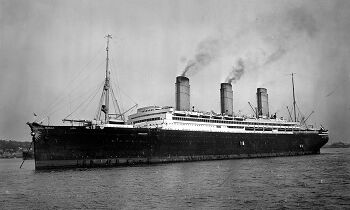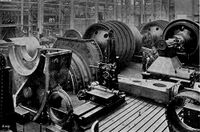RMS Imperatrice Bianca
This article is incomplete because it is pending further input from participants, or it is a work-in-progress by one author. Please comment on this article's talk page to share your input, comments and questions. Note: To contribute to this article, you may need to seek help from the author(s) of this page. |
 RMS Imperatrice Bianca at anchor after arriving in Etra during her maiden voyage in 1910.
| |
| History | |
|---|---|
| Name: | RMS Imperatrice Bianca |
| Namesake: | Empress Elliana |
| Owner: |
|
| Port of registry: |
|
| Route: | Fumicino – Aonomori – Etra |
| Ordered: | 11 April 1900 |
| Builder: | Royal Shipbuilders of Cacerta, Fumicino, Cacertian Empire |
| Laid down: | 25 December 1900 |
| Launched: | 25 February 1903 |
| Completed: | 27 December 1903 |
| Maiden voyage: | 4 January 1904 |
| In service: | 4 January 1904 |
| Out of service: | 23 September 1933 |
| Fate: | Retired at Paviolo after 29 years of service. Later scrapped for parts and material during the Siduri War. Superstructure dismantled in Fumicino and hull at Paviolo. |
| Status: | Scrapped |
| General characteristics | |
| Class and type: | Empress-class ocean liner |
| Displacement: | 52,440 tons |
| Length: | 276 meters |
| Beam: | 29.9 meters |
| Draught: | 10.7 meters |
| Decks: | 11 |
| Installed power: |
|
| Propulsion: |
|
| Speed: | 24 knots (44 km/h) max |
| Capacity: | 3,812 passengers |
| Crew: | 1,175 crew |
RMS Imperatrice Bianca (Italian: White Empress) was a Cacertian ocean liner and the lead ship of the White Star Line’s Empress-class ocean liners. She held the title of largest ocean liner in the Bara Sea until the introduction of the RMS Imperatrice Rossa which entered service later in 1904.
Imperatrice Bianca was an iconic passenger ship of the Cacertian Empire at the time. She was commonly contracted by Empress Elliana as her private transport around the region and was the host of a number of royal pleasure cruises during her service. Her travels took her to Allamunnika, Shalum, Ossoria, Acrea, Kirisaki, Syara, and Akashi during her 29 years at sea.
She was eventually withdrawn from service in 1933 and was transported to Paviolo during the Empire’s waning years. Originally intended to be refurbished and returned to service, she was scrapped in 1937 for resources during the Siduri War although decorative elements of the ship were removed and later preserved.
Background and Construction
The Imperatrice Bianca was built in Fumicino, Lombardo as the first of three Empress-class ocean liners—the others being Imperatrice Rossa and Imperatrice Grigia. Upon their completion, they were the largest vessels in the White Star Line’s fleet which consisted of 85 steamers and tenders in 1904. The White Star Line was virtually uncontested in the Siduri market of passenger steamers at the time and it allowed the company plenty of time to develop ocean liners that focused on grandeur and luxury. White Star Line also sought to upgrade their fleet as the largest ships dated from the late 1880s at the time of the conception of the Empress-class.
The Imperatrice Bianca was constructed by the Royal Shipbuilders of Cacerta (CNRC), the single largest and most decorated shipbuilding company in the Empire. The White Star Line worked closely with CNRC in developing and designing the ships. Costs were not taken into consideration in their design and the CNRC was allowed to spend what it needed in order to meet the overall objective of the construction of the Empress-class of ships.
Construction of Imperatrice Bianca began on 25 December 1900 and continued uninterrupted until her hull was completed in Late February. She was launched from the CNRC shipyards in Fumicino on 25 February 1903 and towed to drydock to complete her fitting out. Significant care was taken in completing the ship and the Imperatrice Bianca was finally completed on 27 December 1903, slightly over three years after her keel was laid down in 1900.
Design
At a length of 276 meters, Imperatrice Bianca was nearly 30 meters longer and slightly wider than the preceding Knight-class. The beam of the ship was 29.9 meters with a draft of 10.7 meters. They dwarfed their predecessors in weight, weighing in at 52,440 tons making them 15,000 tons heavier than the White Star Line’s previous class of ocean liner. One of the most defining characteristics of the Imperatrice Bianca was an imposing phoenix figurehead, representing House Sarissita, which adorned the ship’s forepeak.
Imperatrice Bianca was equipped with four steam turbines that offered greater reliability while operating at high speed as well as lower fuel consumption than their reciprocating engine counterparts. Each of the ships four propellers were driven directly by the turbines with the inboard shafts equipped with additional reversing turbines. In an attempt to improve efficiency, the two inboard propellers rotated inwards while the outboard rotated outwards. The outboard turbines operated at high pressure with the exhaust steam passing at low pressure to the inboard turbines.
The vessel’s electrical plant consisted of four steam-driven electrical generators, each capable of producing 400 kW. Two 30 kW auxiliary generators served as an emergency power source in the event the primary generators were out of service or damaged.
Fifteen watertight bulkheads separated the ship into sixteen primary compartments; each of these bulkheads featured vertically closing watertight doors that could seal off compartments in the event of an emergency. These doors could be activated locally or automatically from the bridge and designed to prevent any flooding water from spreading to other parts of the ship in the event of a hull breach.
The ship was also equipped with her own waterworks and was capable of heating and pumping water to all parts of the vessel. The main water supply was usually taken aboard while at port, but the Imperatrice Bianca and her sister vessels were also able to distill seawater if needed. She also possessed a network of insulated ducts that conveyed warm air throughout the ship which was driven by a series of electrical fans.
Unlike the White Star Line’s previous vessels, the Imperatrice Bianca maintained a 24-hour radiotelegraph service that allowed passengers to send and receive telegrams (although navigation messages, weather reports, and other warnings took priority). The radio room was located on the ship’s boat deck adjacent to the officers’ quarters and contained a soundproof room that stored the transmitter and motor-generator. The 5 kW rotary spark-gap transmitter was the most powerful transmitter in service on a Cacertian civilian ship and was capable of transmitting over a radius of 560 kilometers.
